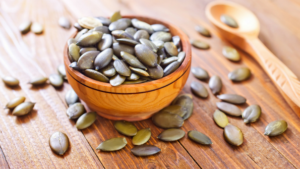Disclosure: This post by Lauren Grant was provided by New Hope Network. I am a member of the New Hope Influencer Co-op, a network of health and wellness bloggers committed to spreading more health to more people. The parts in italics? All me!
Eating right doesn’t have to equal mundane meals and slim wallets. And this list of the ten healthiest—and cheapest—plant-based foods proves just that. From leafy greens and grains to fruit and hearty vegetables, these ingredients guarantee nutritious, budget-friendly meals that will satisfy even the hungriest of appetites. So say good-bye to boring breakfasts and flavorless side dishes and get in the kitchen with these versatile recommendations. They provide endless options for healthy, money-saving meals that will fuel your body and save your wallet. There is something for everyone!
Nuts for Seeds?
Pumpkin Seeds. When it comes to buying seeds and nuts, you may experience some sticker shock. Stop struggling between health and savings, and pick up a bag of nutritious, budget-friendly pumpkin seeds.
Cost: $0.30 per ¼-cup serving ($4.25 per pound).
Benefits: Pumpkin seeds—or pepitas, as they’re called when they’re shelled—pack a lot of health benefits for their little size. Aside from offering a high amount of manganese, just ¼ cup of pepitas contains nearly 50 percent of your daily need for magnesium—important for muscle, heart and bone health. That same serving size is high in heart-healthy fats and adds almost 10 grams of protein to your diet.
Ideas: I like pumpkin seeds on my salads, but I also like them plain (cooked, even in the shell!). Next time you gut your Jack o’ Lantern, save the seeds, wash and pat dry, then spread on a cookie sheet with a little oil and salt; bake until they start to turn brown, stirring occasionally. Buy in bulk to save money. Spending to treat yourself? Try Health Warrior’s pumpkin seed bars!
Need Some Color in Your Life?
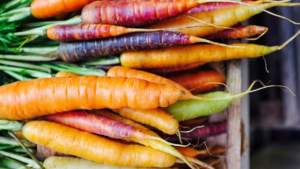 Carrots & Cauliflower. With a combined résumé that’s pretty stunning, these two powerhouse veggies are vital when it comes to filling your plate and your wallet.
Carrots & Cauliflower. With a combined résumé that’s pretty stunning, these two powerhouse veggies are vital when it comes to filling your plate and your wallet.
Cost: 0.20 to $0.50 per cup ($0.98 to $2.48 per pound).
Benefits: One cup of carrots alone surpasses your daily need of vitamin A. Throw in the various antioxidants (beta-carotene being the most well-known, and a precursor to vitamin A), and you’re already looking at one of the healthiest foods you can buy. Add a cup of cauliflower to up the ante. Just 1 cup contains 73 percent of your daily vitamin C needs; plus it’s been shown to decrease the risk of various cancers.
Ideas: Grate cauliflower and cook, use in place of rice. Carrots roast nicely either whole or chopped into pieces, alone or with other root vegetables, but my favorite way to eat them (in the winter, at least) is in carrot and roasted red pepper soup. Make a hearty all-vegetable meal by topping a baked potato with cauliflower and carrots; add broccoli for color variety and top with butter or cheese if that’s your thing.
Bean There, Tried That?
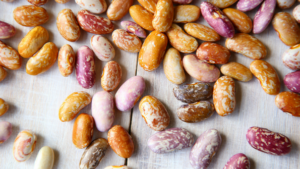 Pinto Beans. Whether dried and cooked or used straight from the can, heart-healthy pinto beans are one of the cheapest protein sources you can buy.
Pinto Beans. Whether dried and cooked or used straight from the can, heart-healthy pinto beans are one of the cheapest protein sources you can buy.
Cost: $0.04 per ½-cup cooked serving from dried beans ($0.80 per pound dried beans) and $0.20 per ½-cup serving from canned beans ($0.64 per pound canned beans).
Benefits: Not surprisingly, pinto beans are packed with fiber. Just ½ cup of cooked beans gives you more than 30 percent of your daily recommended intake for dietary fiber. Additionally, pinto beans contain high levels of folate, magnesium and potassium, all of which contribute to heart health. And, being high in protein and iron makes pinto beans a favorable plant-based alternative to red meat.
Ideas: My go-to “lazy dinner” is the homemade version of Cafe Yumm’s classic bowl: brown rice, beans of your choice, salsa and/or pico de gallo and/or chopped tomatoes, top with cheese and Yumm sauce. Make it fancier by adding some sliced olives, chopped onions, garlic, cilantro, and cheese. If quac is your thing, that would work too. (Yuck.) Need Yumm sauce? Find out where to buy it here.
Feeling Fruity?
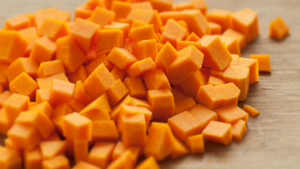 Butternut Squash. This hourglass-shaped fruit (yes, it’s a fruit) has taken a backseat to summer squash for far too long. The butternut is a winter squash that offers more benefits and versatility than is often thought.
Butternut Squash. This hourglass-shaped fruit (yes, it’s a fruit) has taken a backseat to summer squash for far too long. The butternut is a winter squash that offers more benefits and versatility than is often thought.
Cost: $0.40 per 1-cup serving ($1.31 per pound).
Benefits: Although some produce hide their nutrients, butternut squash isn’t afraid to flaunt them. Its brightly colored orange flesh indicates the presence of beta-carotene, which we know to fight certain cancers and protect eye health. Beyond that, this gourd adds a healthy amount of fiber and vitamins A and C to your diet, which in combination contribute to a strong immune system, bone and tissue health and healthy blood sugar levels.
Ideas: Not a big squash eater here…but I do love chopped, baked butternut squash served warm on a winter salad (kale, goat cheese, dried cranberries, sunflower seeds) or in a cold quinoa or rice-based salad (especially pretty with the black “forbidden rice”). In the winter, I love using it in soup. If you’re not up for cooking, look for Pacific Foods butternut squash soup (it comes in a carton, so if you take it to work for lunch you can make it last two days).
Would it Kale You to Eat Greens?
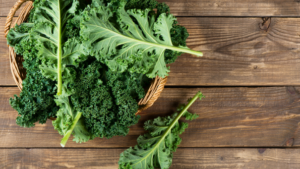 Kale. This once rare but now beloved veggie can be found on tables and menus everywhere. The popularity of this leafy green has caused prices to drop, and you should take advantage of its nutrition prowess.
Kale. This once rare but now beloved veggie can be found on tables and menus everywhere. The popularity of this leafy green has caused prices to drop, and you should take advantage of its nutrition prowess.
Cost: $0.11 per 1-cup serving ($1.60 to $2.00 per pound). (I seriously dare you to try to eat a pound of kale. I swear it cannot be done.)
Benefits: Kale contains more lutein, a type of carotenoid important for eye health, than any other produce. It’s also high in manganese and vitamins A, C and K, all of which contribute to kale’s health benefits—such as lowering your risk of some cancers, reducing your risk of blood clots and boosting your bone and tissue health. Just 1 cup of loosely packed kale contains 20 to 25 percent of your daily vitamin C needs.
Ideas: Before I started to like the taste of kale, I used to “hide” it in my smoothies. Turns out I just prefer thinly sliced kale to big kale leaves–try it, you might like it better too! I am particularly fond of the chopped salad kits by Taylor Farms, Eat Smart, and Fresh Express. Yes, they definitely increase the cost of the kale, but they also ensure I will eat it–wasted food is wasted money.
Fancy Something Fuzzy?
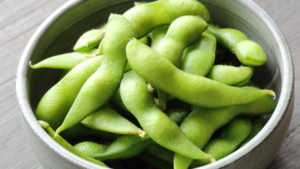 Frozen Edamame. High in fiber and protein and low in unhealthy fats, soybeans are an easy and healthy way to get more bang for your buck. Not many protein sources render as strong of a nutritional profile, which lands edamame on this list.
Frozen Edamame. High in fiber and protein and low in unhealthy fats, soybeans are an easy and healthy way to get more bang for your buck. Not many protein sources render as strong of a nutritional profile, which lands edamame on this list.
Cost: $0.34 per ½-cup serving ($2.72 per pound) of frozen, shelled edamame.
Benefits: Edamame contains a long list of vitamins and minerals (some rarely heard of), with the most notable being iron, manganese, B vitamins and vitamin K. Additionally, edamame is a complete protein, which means it contains all of the nine essential amino acids, a rarity in plant protein sources.
Pro tip: You can find edamame at Trader Joe’s, and often at discount grocers such as Grocery Outlet. It’s easy to steam, and you can even warm it in the microwave. If you buy the edamame still in the pods, it tends to be substantially cheaper than the shelled stuff; I find it helpful to buy the pods so it takes me longer to eat it.
Fuzzier?
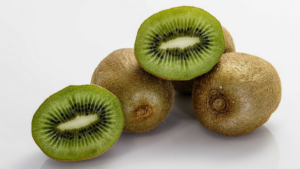 Kiwifruit. This little fruit packs flavor, nutrition and a gorgeous green hue inside an unusual fuzzy peel. Simply slice in half and scoop out flesh with a spoon, or peel and slice, or even eat it sliced with the peel on (wash it first, of course) for a quick, healthful snack.
Kiwifruit. This little fruit packs flavor, nutrition and a gorgeous green hue inside an unusual fuzzy peel. Simply slice in half and scoop out flesh with a spoon, or peel and slice, or even eat it sliced with the peel on (wash it first, of course) for a quick, healthful snack.
Cost: $0.53 per fruit ($3.56 per pound).
Benefits: An incredible source of vitamin C, kiwi is a good option when oranges become mundane. Just one kiwi serves up a hefty amount of dietary fiber and more than 30 percent of your daily needs for vitamin K. This small green fruit, speckled with tiny seeds, has been found to benefit cardiovascular health and respiratory problems such as asthma, shortness of breath and coughing.
Lunchbox Envy: I first learned to love kiwi when a classmate brought one in her lunch. We used to peel them with our fingers–messy, but satisfying–but you can also slice it in advance. Kiwi is really yummy frozen, and frozen sliced kiwi looks pretty in drinks and sparkling water.
Are You the Saucy Type?
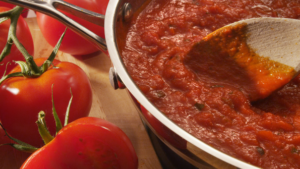 Marinara Sauce. Although it may be surprising to see a sauce on this list, marinara has earned its place. Made primarily of whole foods, including tomatoes and spices, marinara contains a long index of antioxidants. But be sure to check labels and look for marinara with the fewest grams of added sugars and sodium.
Marinara Sauce. Although it may be surprising to see a sauce on this list, marinara has earned its place. Made primarily of whole foods, including tomatoes and spices, marinara contains a long index of antioxidants. But be sure to check labels and look for marinara with the fewest grams of added sugars and sodium.
Cost: $0.32 per ½-cup serving ($1.92 per 24-ounce jar).
Benefits: Tomatoes are naturally high in the antioxidant lycopene—thought to have cancer-prevention benefits—and when cooked, lycopene becomes more readily available to absorb. Marinara also provides a good amount of iron and vitamin C.
Top tip: It’s not hard to make your own sauce, and then you can control how much sugar and salt is added. You don’t even have to start with fresh tomatoes–try canned tomatoes or tomato paste, and add an Italian herb blend. I like mine with garlic, and sometimes pieces of bell pepper and onions. If you have picky eaters, try making your sauce relatively plain, and offer a buffet of add-ins, such as mushroom pieces or grated Parmesean cheese.
Sticks to Your Ribs, They Told Me…
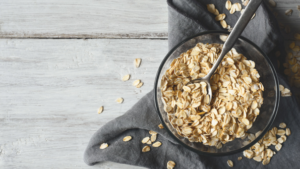 Oats. A quick, nutritious breakfast, old-fashioned oats offer a myriad of health benefits in just one bowl. This wallet-friendly whole-grain can be enjoyed sweet or savory, and is a great foundation for a healthful meal or snack.
Oats. A quick, nutritious breakfast, old-fashioned oats offer a myriad of health benefits in just one bowl. This wallet-friendly whole-grain can be enjoyed sweet or savory, and is a great foundation for a healthful meal or snack.
Cost: $0.07 per ½-cup serving ($1.09 per pound).
Benefits: Naturally gluten-free (but often processed in facilities where gluten-containing grains are also processed), oats deliver almost 10 percent of your recommended daily fiber needs in just ½ cup cooked, along with 3 grams of protein. Also, the daily intake of unrefined, concentrated sources of fiber in oats has been found to reduce the risk of cardiovascular disease, type 2 diabetes and breast cancer. Now that’s a healthy carbohydrate!
Warning!! If you (or the person you’re serving the oats to) is celiac or has a gluten allergy, be absolutely certain to look for oats that are certified gluten-free. That ensures the oats were processed in a place and manner that ensures they will not be cross-contaminated. Buying in bulk might be cheaper, but not if it’s going to make you ill.
Keen for Something Ancient?
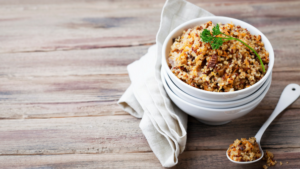 Quinoa. Although this seed has been around since 1200 AD, quinoa took the world by storm just a few years ago, thanks to its incredible nutrient profile, credited with strengthening warriors through the ages.
Quinoa. Although this seed has been around since 1200 AD, quinoa took the world by storm just a few years ago, thanks to its incredible nutrient profile, credited with strengthening warriors through the ages.
Cost: $0.21 per ¾-cup cooked serving ($2.14 per pound).
Benefits: These tiny seeds provide 8 grams of complete protein and nearly 60 percent of your daily manganese needs in each ¾-cup cooked serving, making it an ideal plant-based protein. It contains essential fatty acids and heart-healthy fats, as well as anti-inflammatory benefits—proving that good things do, after all, come in small packages.
More than salad! Quinoa is often served as a side dish or salad, like rice. You can add it to soups, breads, meat-loaf (and meatless-loaf!), and a wide variety of other dishes. I’m also a fan of Qrunch, quinoa-based frozen foods. Qrunch products are certified gluten-free and made of ingredients you recognize. In addition to burger-type patties, I really like the “breakfast toastables” which are tasty with syrup, or can be a quick grab-and-go hand-held breakfast.
Stretch Dollars While Eating Well?
I’d love to hear how you enjoy these foods! Is there a recipe you like to use them in? Or do you prefer some other inexpensive yet nutritious finds?
